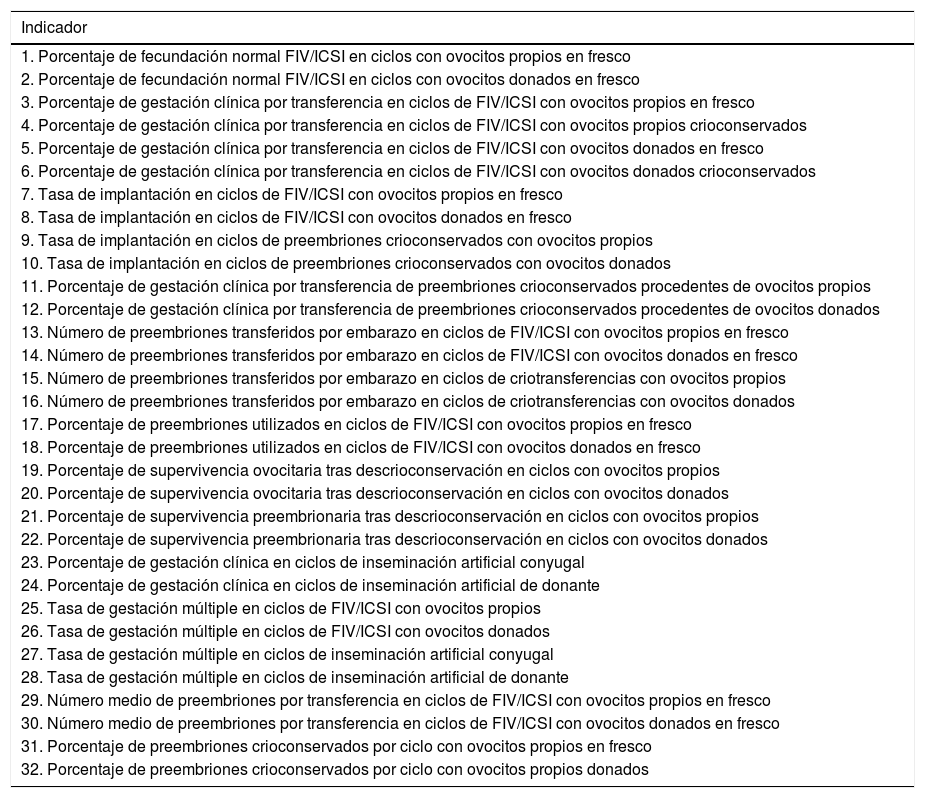Recientes cambios en la legislación española obligan a los centros de reproducción asistida españoles a comunicar al Registro Nacional de Actividad-Registro SEF su actividad y los resultados obtenidos a partir del año 2014. El objetivo de este trabajo es analizar la repercusión que los cambios legislativos recientes hayan podido tener en la estimación de las especificaciones de 32 indicadores de calidad descritos en la UNE 179007 para el Laboratorio de Repoducción Humana Asistida (LRHA) mediante el método del estado del arte.
Material y métodosSe utilizó el método basado en el estado del arte a partir de datos del Registro SEF (2010-2013) de participación voluntaria y del Registro Nacional de Actividad-Registro SEF del Registro de Interés por el Ministerio de Sanidad, Servicios Sociales e Igualdad de 2014 de participación obligatoria. En todos los años se utilizó la metodología descrita por Buño et al. (2008) para el cálculo de la especificación de calidad a nivel deseable, la cual, de modo resumido, corresponde al nivel de calidad alcanzado por el 75% de los mejores laboratorios (percentil 25 de la distribución de valores de cada uno de los indicadores analizados). Se calcula el IC 95% del percentil 25 para determinar la imprecisión de dicha estimación.
ResultadosLa imprecisión de las especificaciones estimadas ha disminuido al poder disponer de información de casi todos los centros de TRA nacionales. Nuestros resultados han puesto de manifiesto la consistencia del método del estado del arte, pues el 85% (26/32) de las especificaciones de los indicadores de calidad permanecen estables a lo largo del tiempo. Solo se han observado cambios significativos en 6 especificaciones de los indicadores. Las 2 especificaciones de los indicadores que han aumentado significativamente son «Tasa de supervivencia a la crioconservación de embriones procedentes de ovocitos frescos propios y donados» y «Porcentaje de embriones evolutivos o utilizados»; disminuyendo significativamente «Número medio de preembriones transferidos en fresco procedentes de ovocitos propios», «Porcentaje de gestación por transferencia de embriones procedentes de ovocitos propios frescos» y «Tasa de gestación múltiple en ciclos de FIV/ICSI».
DiscusiónLos cambios observados en las especificaciones de algunos indicadores que aumentan de forma significativa reflejan cambios en la práctica clínica. Aun así es necesario mejorar la validez de algunos indicadores de calidad de la UNE, ya que su formulación actual no permite estimar la calidad de la prestación asistencial que pretende analizar.
Under recent changes in Spanish law, assisted reproduction centres must inform the National Registry of Activity-SEF Registry of their activity and of the results obtained since 2014. The present study analyses the repercussions of these legislative changes on determining the specifications for 32 quality indicators described in the UNE 179007 standard.
Material and methodsA state-of-the-art method was applied to data obtained from the SEF Register (2010-2013), participation in which is voluntary, and from the National Registry of Activity-SEF Registry administered by the Ministry of Health, Social Services and Equality, participation in which has been mandatory since 2014. For each year of the study period, the method used was that described by Buño et al. (2008) for calculating the quality specification at a desirable level. In short, this corresponds to the quality level reached by 75% of the best laboratories (the 25th percentile of the distribution of values for each of the indicators analysed). The 95% confidence interval of the 25th percentile was calculated to determine the margin of error of this estimate.
ResultsThe imprecision of the studied specifications has decreased, as information was available from almost all the ART centres in Spain. Our results corroborate the robustness of the state-of-the-art method, with 85% (26/32) of the quality indicator specifications remaining stable over time. Significant changes were only observed in 6 indicator specifications. The 2 specifications that increased significantly were “Survival rate to cryopreservation of embryos from donated and own fresh oocytes” and “Percentage of embryos in evolution or used”. On the other hand, there were significant decreases for “Mean number of pre-embryos transferred fresh from own oocytes”, “Percentage of gestation by embryo transfer from fresh own oocytes” and “Multiple gestation rate in IVF/ICSI cycles”.
DiscussionThe significant increases observed in the specifications of some indicators reflect changes in clinical practice. Nevertheless, it is necessary to improve the validity of some UNE quality indicators, since with their current formulation, the quality of the treatment provided cannot be determined.











